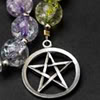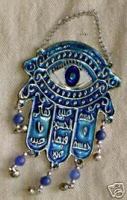The act of “casting charms”, a term sometimes used for  working with amulets and talismans, is one that many beginners and seasoned practitioners of magick and the Craft work with on a regular basis. Some do it with intent; some are doing it without even knowing it. The terms amulet and talisman are often used interchangeably but they are two distinct and different magickal devices. Learning to identify each and answering the “which is which” question can help to open up a doorway for better understanding of how to work with these charms while helping you to create some powerful personal magickal devices.
working with amulets and talismans, is one that many beginners and seasoned practitioners of magick and the Craft work with on a regular basis. Some do it with intent; some are doing it without even knowing it. The terms amulet and talisman are often used interchangeably but they are two distinct and different magickal devices. Learning to identify each and answering the “which is which” question can help to open up a doorway for better understanding of how to work with these charms while helping you to create some powerful personal magickal devices.
What is an amulet?
Amulets are one of the oldest magickal items that we know of. For thousands of years they have been used to help protect individuals, the homes and even other objects. Amulets are objects, often worn as ornamentation or used to appear decorative in the home, which have been enchanted with spells or charged with energy, with the specific purpose of protecting someone or some place from evil, harm or negative forces and energy.
One of the most well known curses, the Evil Eye, has had amulets employed to protect against it for centuries. Believed to be nothing more than a look with biting ill intent, the Evil Eye is thought to cause injury, bad luck, even death. Many feel that if someone holds a powerful feeling of jealousy, envy or dislike for someone they can easily cast the Evil Eye upon them with this look of ill will. While the belief in the Evil Eye is strongest in places like the Middle East, parts of Asia, Africa and Europe, the belief came to the new world with slaves and immigrants and now you can find people all over the world using and wear amulets designed to ward off or even deflect the power of this curse.
In the case of the Evil Eye there are several symbolic items used and today we often find them together as a single amulet including the eye, the hand, and the horseshoe. Often you will find two of these together, most commonly the eye placed within a hand. It combines the traditional Turkish all-seeing eye charm, a symbol of protection from the Supreme Being, placed within a down facing hand, an Arab symbol known as the hamsa hand, hamsa meaning “five” and referring to the fingers on the hand. The history of the hamsa hand is quite interesting and has been attributed to Jewish and Islamic traditions as well, however archaeological evidence seems to suggest that the down-turned hand as a protective symbol predates Judaism and Islam, suggesting that it is an ancient Middle Eastern symbol of the hand of a Goddess reaching out to offer protection and guidance.
So when we are talking about an amulet we are talking about an object that is mainly worn on the body, it can be in the form of a necklace, bracelet, pin, etc, and is charged with the specific act of protection. It is means to protect and repel negative, evil and unwanted forces.
What is a talisman?
In the case of a talisman, we are talking about an object that has been crafted with the intention of drawing something to the user. This can be an object charged and enchanted to draw power, good luck, improved health, or any other similar objective. The main idea is that with a talisman you are working to draw something toward you. The other and somewhat less crucial piece here with a talisman is that it is an object believed to hold magickal power in and of itself. This is often the definition seen related to talismans in fiction and even in some historical texts. And while this may be part of the history of the talisman, and we certainly do see these objects as magickal, today’s modern use is mainly defined as an object created to draw a specific energy or quality to the user.
Another way that talismans and amulets differ is that while an amulet can be a more general item, like the mass produced and largely recognizable items talked about above (the St. Christopher metals that many people use for protection during travel is another example of a common amulet), a talisman is more person and is tailor made for the individual, or more likely by the individual themselves, for their specific needs at a specific time, such as during a full moon or with the moon in a specific astrological alignment. Many times a talisman will be made using natural objects such as rocks, feathers, metals and woods, or they can be simply drawn on parchment. Sigils are sometimes used as markings on rocks or parchment as part of a talisman.
Another form that a talisman can take, and one that many modern practitioners work with at some point, is what we often refer to as a sachet; a small piece of cloth or a small cloth “spell bag” that is filled with specific herbs, stones, parchment sigils or markings, and other meaningful objects, which have been cleansed, blessed and charged together for a specific purpose. Love sachets are very common. These often consist of a small red bag, a mixture of herbs related to love such as rose, jasmine, mandrake, and clove, a heart shaped piece of red silk, and a piece of parchment with your name, your astrological symbol and a drawing of two entwined hearts. The items are all charged and blessed, placed within the bag and the bag is then sewn closed with red string while words of blessing and intent are chanted over the bag to seal and charge it. The bag is then often carried with the person on their receptive side of the body (e.g. the left side for someone that is right handed). It can be carried in a pocket or pinned to the inside of a jacket or pants.
The debate about amulets and talismans
There are a few other definitions for amulets and talismans and the two terms are often used interchangeably which can lead to confusion about what sort of object does what. While in a roundabout way it can be argued that through the very act of protection and warding an amulet draws something to the user, this is not its main objective. And the reverse can be said of a talisman; while a talisman is doing its job of drawing something to an individual, like in the case of a talisman for good luck, it does somewhat repel bad luck; but again this isn’t its main objective.
Raymond Buckland, in his book “The Complete Book of Witchcraft” has a very different take on amulets and talismans. He states that an amulet is a natural object, such as a stone or crystal, especially the often talked about “Holy Stones” or “Hag Stones” which is simply a stone with a naturally occurring hole in the center. Buckland states that an amulet cannot be created and can only be adopted and that if an amulet is engraved and consecrated (e.g. taking a stone from the ocean and carving a sigil for protection on it) it would then become a talisman.
With regards to a talisman, Buckland gives these the definition of a man-made object which has been empowered with magickal energy, especially for either warding off evil or drawing good luck. He then states that the most common form of a talisman is that of a metal disc worn as a pendant which is often two sided; one side holds the objective of the talisman while the other is personalized by the wearer.
Definitions from Webster’s Dictionary state that an amulet is a charm worn around the neck to protect against evil while a talisman is something with an engraving of figures or symbols to bring good luck and keep evil away and can be a ring or stone.
So while some definitions will vary the essence of the objects are still the same. An amulet is used to protect and repel negativity while a talisman is used to draw in energy. Both can be object that can be worn or placed in the home or other space based on what or who it is meant to protect. And, regardless of which you use or create, your personal interaction in key to the success of the object.
The importance of intention
Whether you’re working with an amulet or a talisman visualization, intention and energy are extremely important. These objects all need to be given a specific charge and a specific magickal direction which is done through either the act of blessing and charging in the case of an amulet or during its creation in the case of a talisman. With a talisman, creating and working with a ritual to help set its intention is the best way to activate it. A simple ritual cleansing, blessing and charging is usually all that is needed in the case of amulets. However, as with all other magickal procedures, research and experiment with things that you feel drawn to but know that the purpose and goal here is to ensure that you are using clear visualization and intent with your objects.






This is a really interesting post. One that deserves more than one reading.
I wear a gold Tibetan amulet that was filled with blessed relics and prayers by my two Tibetan teachers and then sealed. So that my talisman wil always be with me, it is tattooded on my hand. I am from the middle east and have a Chamsa on the top of my right hand. I carry a small goddess and crystal imbued with Reiki and special intentions for protection.
I am so happy to be following your blog, since I learn so much in one place.
Blessed be.
An informative and well-written post. Love your blog 🙂